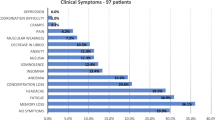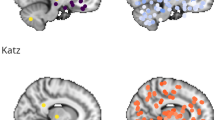Abstract
Background
Evidence indicates that the SARS-CoV-2 virus can infect the brain, resulting in central nervous system symptoms. However, there is a lack of a longitudinal imaging study investigating the impact of Coronavirus disease 2019 (COVID-19) infection on brain function. Consequently, this study aimed to fill this knowledge gap using functional magnetic resonance imaging (fMRI).
Methods
Twenty-one participants underwent two resting-state fMRI scans before and after infection. The amplitude of low-frequency fluctuations (ALFF) and regional homogeneity (ReHo) were assessed to identify the brain function changes. Additionally, voxel-based morphometry (VBM) was utilized to assess changes in brain structure. Subsequently, brain regions that showed significant differences were identified as regions of interest (ROI) in functional connectivity analysis (FC).
Results
After infection, ALFF was increased in the bilateral paracentral lobe and postcentral gyrus while decreased in the bilateral precuneus. Moreover, ReHo was decreased in the cerebellar vermis, accompanied by a decrease in FC with the bilateral postcentral gyrus. Furthermore, gray matter volume (GMV) reduction was observed in the left thalamus. The results of the correlation analysis revealed a negative correlation between ALFF values in the bilateral precuneus and scores on the self-rating anxiety scale (SAS) in pre- and post-infection datasets.
Conclusion
Neuroimaging alterations may occur before the manifestation of clinical symptoms, indicating that the functioning of the motor and sensory systems, as well as their connection, might be affected following infection. This alteration can potentially increase the potential of maladaptive responses to environmental stimuli. Furthermore, patients may be susceptible to future emotional disorders.



Similar content being viewed by others
Data availability
The data that support the findings of this study are available from the corresponding author upon reasonable request.
Abbreviations
- COVID-19:
-
Coronavirus disease 2019
- fMRI:
-
Functional magnetic resonance imaging
- ALFF:
-
Amplitude of low-frequency fluctuation
- ReHo:
-
Regional homogeneity
- FC:
-
Functional connectivity
- VBM:
-
Voxel-based morphometry
- GMV:
-
Gray matter volume
- ROI:
-
Regions of interest
- SAS:
-
Self-anxiety scale
- SDS:
-
Self-depression scale
- BMI:
-
Body mass index
References
Pezzini A, Padovani A (2020) Lifting the mask on neurological manifestations of COVID-19. Nat Rev Neurol 16(11):636–644
Koralnik IJ, Tyler KL (2020) COVID-19: A Global Threat to the Nervous System. Ann Neurol 88(1):1–11
Singh S et al (2023) Neurological infection and complications of SARS-CoV-2: A review. Medicine (Baltimore) 102(5):e30284
Yang AC et al (2021) Dysregulation of brain and choroid plexus cell types in severe COVID-19. Nature 595(7868):565–571
Stein SR et al (2022) SARS-CoV-2 infection and persistence in the human body and brain at autopsy. Nature 612(7941):758–763
Crunfli F et al (2022) Morphological, cellular, and molecular basis of brain infection in COVID-19 patients. Proc Natl Acad Sci U S A 119(35):e2200960119
Zang YF et al (2007) Altered baseline brain activity in children with ADHD revealed by resting-state functional MRI. Brain Dev 29(2):83–91
Lv H et al (2018) Resting-State Functional MRI: Everything That Nonexperts Have Always Wanted to Know. AJNR Am J Neuroradiol 39(8):1390–1399
Zang Y et al (2004) Regional homogeneity approach to fMRI data analysis. Neuroimage 22(1):394–400
Buchel C, Friston K (2000) Assessing interactions among neuronal systems using functional neuroimaging. Neural Netw 13(8–9):871–882
Ashburner J, Friston KJ (2000) Voxel-based morphometry–the methods. Neuroimage 11(6 Pt 1):805–821
Cattarinussi G et al (2022) Altered brain regional homogeneity is associated with depressive symptoms in COVID-19. J Affect Disord 313:36–42
Du YY et al (2022) Survivors of COVID-19 exhibit altered amplitudes of low frequency fluctuation in the brain: a resting-state functional magnetic resonance imaging study at 1-year follow-up. Neural Regen Res 17(7):1576–1581
Fischer D et al (2022) Disorders of Consciousness Associated With COVID-19: A Prospective Multimodal Study of Recovery and Brain Connectivity. Neurology 98(3):e315–e325
Lu Y et al (2020) Cerebral Micro-Structural Changes in COVID-19 Patients - An MRI-based 3-month Follow-up Study. EClinicalMedicine 25:100484
Besteher B et al (2022) Larger gray matter volumes in neuropsychiatric long-COVID syndrome. Psychiatry Res 317:114836
Douaud G et al (2022) SARS-CoV-2 is associated with changes in brain structure in UK Biobank. Nature 604(7907):697–707
Bechmann N et al (2022) Sexual dimorphism in COVID-19: potential clinical and public health implications. Lancet Diabetes Endocrinol 10(3):221–230
Mukherjee S, Pahan K (2021) Is COVID-19 Gender-sensitive? J Neuroimmune Pharmacol 16(1):38–47
Vasilevskaya A et al (2023) Sex and age affect acute and persisting COVID-19 illness. Sci Rep 13(1):6029
Zhang L et al (2023) Altered brain activity and functional connectivity in migraine without aura during and outside attack. Neurol Res 45(7):603–609
Yan CG et al (2016) DPABI: Data Processing & Analysis for (Resting-State) Brain Imaging. Neuroinformatics 14(3):339–351
Cavanna AE, Trimble MR (2006) The precuneus: a review of its functional anatomy and behavioural correlates. Brain 129(Pt 3):564–583
Fransson P, Marrelec G (2008) The precuneus/posterior cingulate cortex plays a pivotal role in the default mode network: Evidence from a partial correlation network analysis. Neuroimage 42(3):1178–1184
Nakao T et al (2011) fMRI of patients with social anxiety disorder during a social situation task. Neurosci Res 69(1):67–72
Yuan C et al (2018) Precuneus-related regional and network functional deficits in social anxiety disorder: A resting-state functional MRI study. Compr Psychiatry 82:22–29
Bashford-Largo J et al (2021) Reduced top-down attentional control in adolescents with generalized anxiety disorder. Brain Behav 11(2):e01994
Wu T et al (2021) Prevalence of mental health problems during the COVID-19 pandemic: A systematic review and meta-analysis. J Affect Disord 281:91–98
Ausserhofer D et al (2023) Relationship between depression, anxiety, stress, and SARS-CoV-2 infection: a longitudinal study. Front Psychol 14:1116566
Lim SH et al (1994) Functional anatomy of the human supplementary sensorimotor area: results of extraoperative electrical stimulation. Electroencephalogr Clin Neurophysiol 91(3):179–193
Patra A et al (2021) Morphology and Morphometry of Human Paracentral Lobule: An Anatomical Study with its Application in Neurosurgery. Asian J Neurosurg 16(2):349–354
Casamento-Moran A et al (2023) Cerebellar Excitability Regulates Physical Fatigue Perception. J Neurosci 43(17):3094–3106
Pierce JE et al (2023) Explicit and implicit emotion processing in the cerebellum: a meta-analysis and systematic review. Cerebellum 22(5):852–864
Baumann O et al (2015) Consensus paper: the role of the cerebellum in perceptual processes. Cerebellum 14(2):197–220
Ruscheweyh R et al (2014) Altered experimental pain perception after cerebellar infarction. Pain 155(7):1303–1312
Hilber P (2022) The Role of the Cerebellar and Vestibular Networks in Anxiety Disorders and Depression: the Internal Model Hypothesis. Cerebellum 21(5):791–800
Xu LY et al (2017) Relationship between cerebellar structure and emotional memory in depression. Brain Behav 7(7):e00738
Wang X et al (2018) Alterations of the amplitude of low-frequency fluctuations in anxiety in Parkinson’s disease. Neurosci Lett 668:19–23
Dai P et al (2023) Altered effective connectivity among the cerebellum and cerebrum in patients with major depressive disorder using multisite resting-state fMRI. Cerebellum 22(5):781–789
Duan K et al (2021) Alterations of frontal-temporal gray matter volume associate with clinical measures of older adults with COVID-19. Neurobiol Stress 14:100326
Kamasak B et al (2023) Effects of COVID-19 on brain and cerebellum: a voxel based morphometrical analysis. Bratisl Lek Listy 124(6):442–448
Qin Y et al (2021) Long-term microstructure and cerebral blood flow changes in patients recovered from COVID-19 without neurological manifestations. J Clin Invest 131(8):e147329
Charyasz E et al (2023) Functional map** of sensorimotor activation in the human thalamus at 9.4 Tesla. Front Neurosci 17:1116002
Wolff M et al (2021) A thalamic bridge from sensory perception to cognition. Neurosci Biobehav Rev 120:222–235
Saleki K et al (2020) The involvement of the central nervous system in patients with COVID-19. Rev Neurosci 31(4):453–456
Chen R et al (2020) The Spatial and Cell-Type Distribution of SARS-CoV-2 Receptor ACE2 in the Human and Mouse Brains. Front Neurol 11:573095
Soriano JB et al (2022) A clinical case definition of post-COVID-19 condition by a Delphi consensus. Lancet Infect Dis 22(4):e102–e107
Raveendran AV (2021) Long COVID-19: Challenges in the diagnosis and proposed diagnostic criteria. Diabetes Metab Syndr 15(1):145–146
Premraj L et al (2022) Mid and long-term neurological and neuropsychiatric manifestations of post-COVID-19 syndrome: A meta-analysis. J Neurol Sci 434:120162
Koyama MS et al (2017) Differential contributions of the middle frontal gyrus functional connectivity to literacy and numeracy. Sci Rep 7(1):17548
Lu F, Yang W, Qiu J (2023) Neural bases of motivated forgetting of autobiographical memories. Cogn Neurosci 14(1):15–24
Wirebring LK et al (2022) An fMRI intervention study of creative mathematical reasoning: behavioral and brain effects across different levels of cognitive ability. Trends Neurosci Educ 29:100193
Asadi-Pooya AA et al (2022) Long COVID syndrome-associated brain fog. J Med Virol 94(3):979–984
Acknowledgements
We would like to thank the volunteers for their involvement in the study.
Funding
This study was supported by Zhejiang Province Traditional Chinese Medicine Science and Technology Plan [grant number 2022ZA103].
Author information
Authors and Affiliations
Contributions
** **: Conceptualization, Methodology, Investigation, Data curation, Validation, Formal analysis, Writing—original draft, Visualization, Funding acquisition. Feng Cui: Software, Methodology, Data curation, Formal analysis. Min Xu: Investigation, Writing—review & editing. Yue Ren: Software, Methodology. Lu** Zhang: Conceptualization, Project administration, Writing—review & editing, Supervision, Resources.
Corresponding author
Ethics declarations
Competing interests
The authors declare that they have no competing interests.
Ethics approval and consent to participate
The study was carried out in accordance with the Code of Ethics of the World Medical Association (Declaration of Helsinki) and was approved by the Ethics Committee of Hangzhou TCM Hospital Affiliated to Zhejiang Chinese Medical University (2023KLL014). Informed consent all participants were informed about the experimental procedures and gave their informed written consent to participate in the study.
Consent for publication
Not applicable.
Additional information
Publisher's Note
Springer Nature remains neutral with regard to jurisdictional claims in published maps and institutional affiliations.
Supplementary Information
Below is the link to the electronic supplementary material.
Rights and permissions
Springer Nature or its licensor (e.g. a society or other partner) holds exclusive rights to this article under a publishing agreement with the author(s) or other rightsholder(s); author self-archiving of the accepted manuscript version of this article is solely governed by the terms of such publishing agreement and applicable law.
About this article
Cite this article
**, P., Cui, F., Xu, M. et al. Altered brain function and structure pre- and post- COVID-19 infection: a longitudinal study. Neurol Sci 45, 1–9 (2024). https://doi.org/10.1007/s10072-023-07236-3
Received:
Accepted:
Published:
Issue Date:
DOI: https://doi.org/10.1007/s10072-023-07236-3




